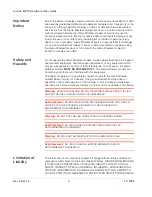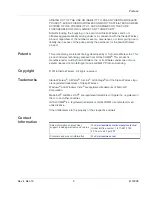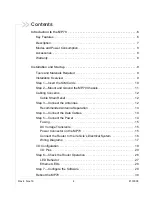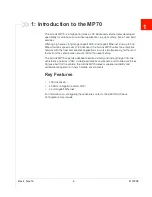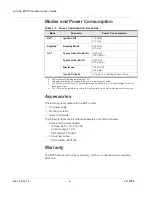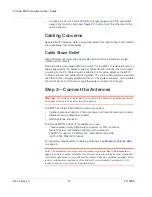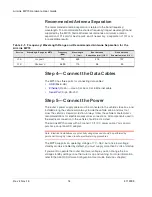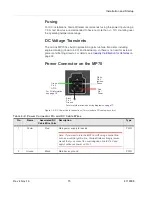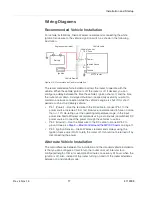
AirLink MP70 Hardware User Guide
Rev 4 Nov.16
12
4119008
•
Connect one end of a short 18 AWG or larger gauge wire to the unpainted,
upper right mounting hole (see
) and connect the other end to the
vehicle chassis.
Cabling Concerns
Separate MP70 antenna, data, and power cables from other wiring in the vehicle
and route away from sharp edges.
Cable Strain Relief
Sierra Wireless recommends using cable strain relief for installations in high-
vibration environments.
Place the cable strain relief within 200 mm (8") of the MP70 to reduce the mass of
cable supported by the power connector under vibration. Ideally, the strain relief
mounting for the DC cable should be attached to the same object as the MP70,
so both the router and cable vibrate together. The strain relief should be mounted
such that it does not apply additional stress on the power connector, i.e. the cable
should not be taut and should not pull the power connector at an angle.
Step 3—Connect the Antennas
Warning:
This router is not intended for use close to the human body. Antennas should
be at least 8 inches (20 cm) away from the operator.
The MP70 has three SMA female antenna connectors:
•
Cellular antenna connector: Primary receive and transmit antenna connector
•
Cellular Diversity antenna connector
•
GNSS antenna connector
The AirLink MP70s with Wi-Fi capability also have:
•
Three reverse polarity SMA male connectors for Wi-Fi antennas.
Sierra Wireless recommends cabling out the antennas.
The MP70 supports 2.4 MHz (2400–2500 MHz) and 5GHz
(4900–5900 MHz) Wi-Fi bands.
For regulatory requirements concerning antennas, see
Note: The antenna should not exceed the maximum gain specified in
page 44. In more complex installations (such as those requiring long lengths of cable and/
or multiple connections), you must follow the maximum dBi gain guidelines specified by the
radio communications regulations of the Federal Communications Commission (FCC),
Industry Canada, or your country’s regulatory body.


